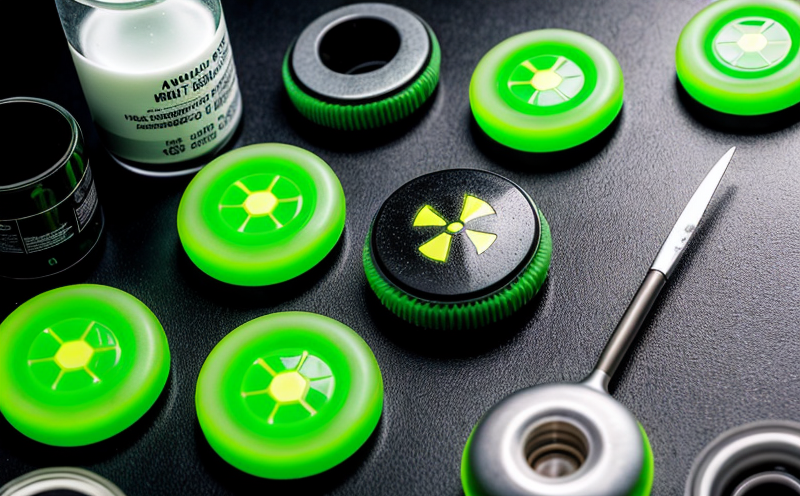ISO 15318 Uranium and Thorium Detection in Foodstuffs
The ISO 15318 standard provides a robust framework for detecting trace levels of uranium (U) and thorium (Th) in foodstuffs. This service is critical for ensuring the safety and quality of food products, especially those destined for human consumption or animal feed. The presence of these heavy metals can have severe health implications if not controlled within safe limits.
Food contamination with uranium and thorium can occur through various means, including soil and water pollution, industrial emissions, and accidental cross-contamination during processing. Uranium is often found in phosphate fertilizers used in agriculture, while thorium may be present as a byproduct from nuclear fuel production or in certain minerals.
The detection of uranium and thorium at trace levels requires precision instruments capable of handling minute quantities of the substances being tested. This service employs advanced analytical techniques such as Inductively Coupled Plasma Mass Spectrometry (ICP-MS) and X-ray Fluorescence Spectroscopy (XRF). These methods provide highly accurate results, ensuring that any detected contamination can be quantified precisely.
The testing process begins with the collection of representative samples from production batches or final products. Specimen preparation involves careful handling to avoid introducing additional contaminants. Once prepared, the samples undergo rigorous analysis according to ISO 15318 guidelines. The results are then reported in accordance with international standards, providing clear and reliable data on uranium and thorium concentrations.
Regular monitoring of foodstuffs for these elements helps maintain compliance with regulatory requirements set by organizations like the European Food Safety Authority (EFSA) and the World Health Organization (WHO). By adhering to stringent detection protocols, laboratories ensure that products remain safe for consumers and comply with international health regulations.
The importance of this service extends beyond mere compliance. It plays a pivotal role in safeguarding public health by identifying potential risks early on. Early detection allows manufacturers to take corrective actions promptly, preventing the release of contaminated products into the market. This proactive approach not only protects end-users but also builds consumer trust and strengthens brand reputation.
Moreover, adherence to ISO 15318 standards demonstrates a commitment to quality assurance and continuous improvement within an organization. It provides reassurance that all processes are being conducted in accordance with recognized best practices, thereby enhancing overall operational efficiency.
- Customer Impact: Regular testing ensures compliance with regulatory requirements, safeguarding public health and protecting brand reputation.
- Prompt identification of contamination allows for timely corrective actions, minimizing potential health risks.
- Building consumer confidence through consistent adherence to international standards reinforces trust in the product quality.
In conclusion, ISO 15318 uranium and thorium detection is an essential service that contributes significantly towards maintaining food safety and ensuring regulatory compliance. Its implementation underscores a company's dedication to producing safe and reliable products, which ultimately benefits both consumers and businesses alike.
Applied Standards
The ISO 15318 standard is widely recognized for its comprehensive approach to detecting uranium and thorium in foodstuffs. This international guideline specifies the requirements, procedures, and methods necessary for accurate measurement of these elements at trace levels.
ISO 15318 emphasizes the importance of using appropriate analytical techniques such as ICP-MS and XRF, which are capable of detecting even minuscule amounts of uranium and thorium. The standard outlines detailed protocols for sample preparation, instrumental calibration, data processing, and reporting results.
The application of ISO 15318 ensures consistent and reliable testing across different laboratories worldwide. This consistency is crucial when comparing results between various testing facilities or jurisdictions. By adhering to this standard, organizations can ensure that their findings are comparable and universally accepted.
Furthermore, compliance with ISO 15318 helps businesses meet regulatory expectations set by governmental bodies such as the EFSA and WHO. These regulations aim to protect public health by setting maximum allowable limits for uranium and thorium in food products. Adherence to these standards not only facilitates easier market access but also promotes safer consumption practices.
Organizations that adopt ISO 15318 demonstrate their commitment to excellence in quality assurance and continuous improvement. This commitment fosters trust among consumers, suppliers, and stakeholders, enhancing overall brand reputation and operational efficiency.
Scope and Methodology
The scope of the ISO 15318 service encompasses the detection of trace levels of uranium (U) and thorium (Th) in foodstuffs. This includes a wide range of products such as fruits, vegetables, grains, dairy goods, meats, and processed foods. The methodology employs advanced analytical techniques to ensure precision and reliability.
The testing process involves several key steps: sample collection, preparation, analysis using ICP-MS or XRF, and final reporting. Sample collection is crucial; it must be representative of the entire batch or lot being tested. Proper specimen preparation ensures that any detected contamination is not influenced by external factors. The analytical instruments used are calibrated according to ISO 15318 specifications.
The results generated from these analyses are reported in a format consistent with international standards, typically including quantitative values for uranium and thorium concentrations along with any applicable reference levels or limits set forth by regulatory authorities. These reports serve as valuable tools for decision-makers within organizations responsible for maintaining product safety and quality.
By adhering strictly to the methodologies prescribed by ISO 15318, laboratories can ensure that their findings are accurate, reproducible, and internationally recognized. This standardization promotes trust among all parties involved in food production and distribution chains, ultimately contributing to safer consumption practices globally.





